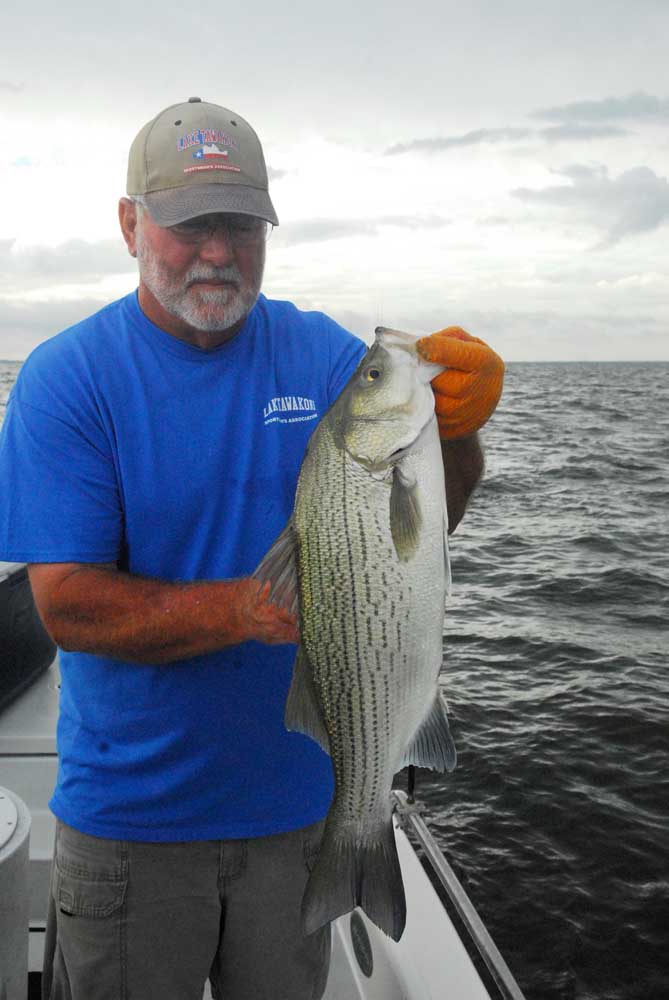Tawakoni Hybrids Are All About Catching On A Good Day
Published 8:47 pm Friday, June 21, 2019

- Guide Joe Read has been chasing hybrid-striped bass, stripers and white bass on Lake Tawakoni since 1988. Despite high water that has scattered the fish, Read has been having an exceptional year on the lake.
LAKE TAWAKONI — It was one of those mornings where it was impossible to count the number of fish pulled over the gunwales of guide Joe Read’s boat.
The rain-shortened trip was more like a track meet running around the boat from one doubled-over rod to another to reel in the hybrid-striper or occasional striper or white bass.
For the first 15 minutes it was a hook-up every time a shad was sent down 19 feet to the bottom before being reeled up one crank. After that, neither of us had a chance to keep count. For nearly two hours straight is was bait, drop, reel, sometimes with a fish on each of the rods in the water. At one point we went from three rods to just two in an effort to keep up. We couldn’t do it.
I don’t know how long I have known Read. I first met him so long ago, a good conversation from him was about 40 words a day. After all these years, he is up to 100, maybe more if you really know him. But while he may not be the biggest talker on the lake, there is no doubt the man can put you on fish.
When it comes to catching the true basses of Lake Tawakoni, I have always considered Read the best. Apparently I am not in the minority as Read has been guiding on the lake since 1988 and the vast majority of his business is repeat customers. They come for a day on the water catching, and that is what makes hybrids, stripers and white bass so good.
“I was hunting and fishing all the time so my wife (Lydia) said you might as well do it as a living,” Read said of his change from a crane operator for a Dallas cement company to full-time fishing guide on the lake.
Living near Tawakoni at the time, that made it the ideal location to start a business, if for no other reason than Lake Fork already had more than enough guides.
The 38,000-acre lake opened in 1960 and had a great reputation for white bass back in an era when people kept fish for something to eat. That changed with growth of bass fishing and certainly with the introduction of Florida largemouth bass and the reign of catch-and-release trophy bass fishing in the late 1970s. Then the emphasis was more on catching that one big fish.
The Tawakoni fishery lost a little shine before starting to become popular again in the 1980s and even more so in the 1990s with the introduction of striped bass, a saltwater species that can adapt and survive in freshwater, and hybrids, a hatchery cross between white bass and stripers. That popularity was spurred by the size and fight of the fish. The current lake record for a striper on Tawakoni is 22.5 and 15.25 for a hybrid.
“I have had a 20-pounder in the boat. It was the striper record at the time,” said Read, noting his best is 18-pounds-plus.
In the early days, the fishing was primarily with live bait. Guides would go out at first light and throw hoop nets to catch shad for the day, and then head back to pick up their clients.
Over time, artificial lures like Sassy Shad and slabs have been added to the arsenal. Although the fish do not spawn, they do make a run to shallow water in the spring. Casting at them then with artificials is Read’s favorite technique.
Since the hybrids do not naturally spawn, they and stripers are stocked by the Texas Parks and Wildlife Department as a put-and-take fishery.
“I have a bunch of clients who like to keep fish, but some don’t. I really don’t care if they keep them as long as they don’t go to waste,” Read said.
Although we were fishing catch-and-release, we wanted a numbers day and hopefully a good fish or two so we went with live bait. We were in fish the first place we stopped and Read quickly invited two other guides to pull in alongside. Between us, there were eight rods in the water and to say it was a rodeo would not even come close to describing the action. It was one of those mornings that would hook a beginner or remind the oldest fisherman why they fished.
Most of the hybrids were in the 3- to 5-pound range, with a few topping 7 or 8. We never really found the big fish, but then again we never moved.
Now 66 years old, Read has been at the guide game so long he does not even count the number of days he is on the water each year. He is out almost daily from early spring through much of the summer. He does spend so much time on Tawakoni he does not remember the last time he took a day to go fish largemouth bass. On the other hand, he admits at “not being as mad” at the fish as he once was and leaves himself plenty of time for fall hunting.
With a storm line approaching the lake, we called it quits after two hours. Honestly, there was no reason to wait out the storm. A 50-plus fish morning fishing with an old friend was plenty.
For more information on fishing Tawakoni, contact Read at 903-880-7207.






